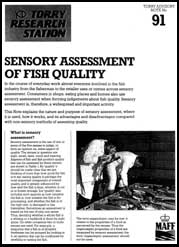Contents Index

Accompanying Notes
Table of Contents
TORRY RESEARCH STATION
TORRY ADVISORY NOTE No. 91
In the course of everyday work almost everyone involved in the fish industry from the fisherman to the retailer uses or comes across sensory assessment. Consumers in shops, eating places and homes also use sensory assessment when forming judgements about fish quality. Sensory assessment is, therefore, a widespread and important activity.
This Note explains the nature and purpose of sensory assessment, where it is used, how it works, and its advantages and disadvantages compared with non-sensory methods of assessing quality.
Crown copyright material is reproduced with the permission of the Controller of Her Majesty's Stationery Office.
This electronic document has been scanned using optical character recognition (OCR) software and careful manual recorrection. Even if the quality of digitalisation is high, the FAO declines all responsibility for any discrepancies that may exist between the present document and its original printed version.
Explains the nature and purpose of sensory assessment, both objective and subjective, as used for assessing aspects of quality of fish and fish products, including frozen products, and distinguishes sensory assessment from the dubious and ill-advised term organoleptic assessment. Explains where sensory assessment is used in the food chain from catching to consumer, and how it is implemented in practice for informal examination, for assessing degrees of freshness and deterioration, for determining the amounts of defects, for formal grading schemes, for product development, and for determination of shelf life. Describes the roles of assessors, uses of taste panels, and considers the problem of fatigue. Gives examples of a descriptive score sheet used for quality assessment of cooked cod, and a descriptive guide to EC freshness grades for white fish. Lists the advantages and disadvantages of sensory compared with non-sensory methods. This Note should be read in conjunction with Notes 58, 92 and 97.
(FAO in partnership with Support unit for International Fisheries and Aquatic Research, SIFAR, 2001).
What is sensory assessment?
Objective and
subjective sensory assessment
Why use sensory assessment?
How sensory assessment
operates in practice
Advantages and disadvantages
Need for expert advice
Further information
Contents Index